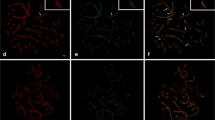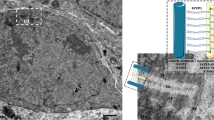Abstract
Serial sectioning followed by three dimensional reconstruction of lateral components of the synaptonemal complex have been used to follow chromosome pairing during the prophase of the achiasmatic meiotic division in the silkworm, Bombyx mori. During leptotene and early zygotene, the lateral components become attached to the nuclear envelope at a specific region, thus forming a chromosome bouquet. The attachment of lateral components to the nuclear envelope precedes the completion of the components between their attachment points. Synapsis and synaptonemal complex formation start during the period of lateral component organization in the individual nucleus. Telomeric movements on the nuclear envelope occur at two stages of the prophase: the chromosome pairing appears to be initiated by an association of unpaired ends of homologous chromosomes, the nature of this primary attraction and recognition being unknown. Secondly, the paired chromosomes become dispersed in the nucleus by shifting of attachment sites of completed synaptonemal complexes at the end of zygotene. This movement is possibly related to a membrane flow occurring during this stage. Membrane material is synthesized at the region of synaptonemal complex attachment. Later, the excess membrane material is shifted to the opposite pole where it protrudes into the lumen of the nuclei thus forming vacuoles. — Two previously undescribed features of chromosome pairing were revealed. In late zygotene, chromosome pairing and synaptonemal complex formation were frequently observed to be delayed or even prevented over a short distance by interlocking of two bivalents, both being attached to the nuclear envelope. Such interlocking of bivalents was not found in pachytene. Secondly, one nucleus was found in which two homologous chromosomes were totally unpaired while the remaining 27 bivalents were completed or in a progressed state of pairing. The lateral components of the two unpaired chromosomes had the same length and were located several microns apart, thus eliminating the possibility of a permanent association of homologous chromosomes before the onset of meiosis in Bombyx mori females. — During pachytene, one of the 8 cells belonging to the syncytial cell cluster characteristic of oogenesis continues the meiotic prophase whereas the remaining 7 cells, the nurse cells, enter a different developmental sequence, finally resulting in their degeneration. The synaptonemal complex of the oocyte develops into a sausage-like structure after pachytene by a deposition of dense material onto the lateral components, thus filling out most of the central region. The diameter of this modified synaptonemal complex reaches at least 300 nm, as compaired to a pachytene width of approximately 130 nm. Also, the length of synaptonemal complexes increases from 212 μ at zygotene/pachytene to at least 300 μ at the modified pachytene stage. In nurse cells, synaptonemal complexes are shed from the bivalents shortly after pachytene simultaneously with a condensation of the chromatin. These free synaptonemal complex fragments associate and form various aggregates, either more or less normal looking polycomplexes or various complex figures formed by reorganized synaptonemal complex subunits. Later stages have not been included in the present investigation.
Similar content being viewed by others
References
Anderson, P. J.: Purification and qnantitation of glutaraldehyde and its effect on several enzyme activities in skeletal muscle. J. Histochem. Cytochem. 15, 652–661 (1967)
Carpenter, A. T. C.: Electron microscopy of meiosis in Drosophila melanogaster females. I. Structure, arrangement, and temporal change of the synaptonemal complex in wild-type. Chromosoma (Berl.) 51, 157–182 (1975)
Comings, D. E., Okada, T. A.: Holocentric chromosomes in Oncopeltus: kinetochore plates are present in mitosis but absent in meiosis. Chromosoma (Berl.) 37, 177–192 (1972)
Counce, S. J., Meyer, G. F.: Differentiation of the synaptonemal complex and the kinetochore in Locusta spermatocytes studied by whole mount electron microscopy. Chromosoma (Berl.) 44, 231–253 (1973)
Craig-Cameron, T. A., Southern, D. I., Pell, P. E.: Chiasmata and the synaptinemal complex in male meiosis of Glossina. Cytobios 8, 199–207 (1973)
Danilova, L. V.: Ultrastructure and development of apyrene and oligopyrene spermatozoa. Proc. Acad. Sci. USSR, Biol. Series 4, 580–587 (1972)
Danilova, L. V.: An electron microscopic study of meiosis in diploid males of the silkworm. Ontogenesis 4, 40–48 (1973a)
Danilova, L. V.: An electron microscope study of meiosis in oligopyrene spermatocytes of the silkworm. Ontogenesis 4, 281–287 (1973b)
Dudley, P. L.: Synaptonemal polycomplexes in spermatocytes of the gooseneck barnacle, Pollicipes polymerus Soverby (Crustacea: Cirripedia). Chromosoma (Berl.) 40, 221–242 (1973)
Engelhardt, P., Pusa, K.: Nuclear pore complexes: “Press-stud” elements of chromosomes in pairing and control. Nature (Lond.) New Biol. 240, 163–166 (1972)
Fiil, A., Moens, P. B.: The development, structure and function of modified synaptonemal complexes in mosquito oocytes. Chromosoma (Berl.) 41, 37–62 (1973)
Friedländer, M., Wahrman, J.: The spindle as a basal body distributor: A study in the meiosis of the male silkworm, Bombyx mori. J. Cell Sci. 7, 65–89 (1970)
Gage, P. L.: The Bombyx mori genome: Analysis by DNA reassociation kinetics. Chromosoma (Berl.) 45, 27–42 (1974)
Galey, F. R., Nilsson, S. E. G.: A new method for transferring sections from the liquid surface of the trough through staining solution to the supporting film of a grid. J. Ultrastruct. Res. 14, 405–410 (1966)
Gassner, G.: Synaptinemal complexes in the achiasmatic spermatogenesis of Bolbe nigra Giglio-Tos (Mantoidea). Chromosoma (Berl.) 26, 22–34 (1969)
Gillies, C. B.: Reconstruction of the Neurospora crassa pachytene karyotype from serial sections of synaptonemal complexes. Chromosoma (Berl.) 36, 119–130 (1972)
Gillies, C. B.: Ultrastructural analysis of maize pachytene karyotypes by three dimensional reconstruction of synaptonemal complexes. Chromosoma (Berl.) 43, 145–176 (1973)
Gillies, C. B.: The structure and extent of synaptonemal complex formation in haploid barley. Chromosoma (Berl.) 48, 441–453 (1974)
Gillies, C. B.: Synaptonemal complex and chromosome structure. Ann. Rev. Genet. 9 (in press, 1975)
Hasimoto, H.: The role of the W-chromosome in the sex determination of Bombyx mori. Jap. J. Genet. 8, 245–247 (1933) (In Japanese)
Hotta, Y., Shepard, J.: Biochemical aspects of colchicine action on meiotic cells. Mol. Gen. Genet. 122, 243–260 (1973)
Hotta, Y., Stern, H.: DNA scission and repair during pachytene in Lilium. Chromosoma (Berl.) 46, 279–296 (1974)
Kawaguchi, E.: Zytologische Untersuchungen am Seidenspinner und seinen Verwandten. I. Gametogenese von Bombyx mori L. und Bombyx mandarina M. und ihre Bastarde. Z. Zellforsch. 7, 519–552 (1928)
Kawaguchi, E.: Der Einfluss der Eierbehandlung mit Zentrifugierung auf die Vererbung bei dem Seidenspinner: II. Beweise für die Beziehung der Geschlechtschromosomen zu den Nukleolen. Cytologia (Tokyo) 9, 88–96 (1938)
King, R. C.: Ovarian development in Drosophila melanogaster. New York and London: Academic Press, Inc. 1970
King, R. C., Akai, H.: Spermatogenesis in Bombyx mori. I. The canal system joining sister spermatocytes. J. Morph. 134, 47–56 (1971a)
King, R. C., Akai, H.: Spermatogenesis in Bombyx mori. II. The ultrastructure of synapsed bivalents. J. Morph. 134, 181–194 (1971b)
King, R. C., Akai, H.: Observations of meiotic chromosomes with an ultrahigh voltage electron microscope. Jeol. News 9e, 12–15 (1971c)
Loche, M., Krishnan, N., McMahon, J. T.: A routine method for obtaining high contrast without staining sections. J. Cell Biol. 50, 540–544 (1971)
Maeda, T.: Chiasma studies in the silkworm Bombyx mori L. Jap. J. Genet. 15, 118–127 (1939)
Meyer, G. F.: A possible correlation between the submicroscopic structure of meiotic chromosomes and crossing over. Proc. Third Europ. Reg. Conf. Prague, 461–462 (1964)
Miya, K., Kurihara, M., Tanimura, J.: Electron microscope studies on the oogenesis of the silkworm Bombyx mori L. III. J. Fac. Agric. Iwate Univ. 10, 59–83 (1970)
Moens, P. B.: Quantitative electron microscopy of chromosome organization of meiotic prophase. Cold Spr. Harb. Symp. quant. Biol. 38, 99–107 (1973)
Moses, M. J.: Synaptinemal complex. Ann. Rev. Genet. 2, 363–412 (1968)
Rasch, E. M.: The DNA content of sperm and hemocyte nuclei of the silkworm, Bombyx mori L. Chromosoma (Berl.) 45, 1–26 (1974)
Rasmussen, S. W.: Ultrastructural studies of spermatogenesis in Drosophila melanogaster Meigen. Z. Zellforsch. 140, 125–144 (1973)
Rasmussen, S. W.: Studies on the development and ultrastructure of the Synaptinemal complex in Drosophila melanogaster. C. R. Trav. Lab. Carlsberg 39, 443–468 (1974)
Rasmussen, S.W.: Ultrastructural studies of meiosis in males and females of the c(3)G17 mutant of Drosophila melanogaster Meigen. C. R. Trav. Lab. Carlsberg 40, 163–173 (1975a)
Rasmussen, S. W.: Synaptonemal poly-complexes in Drosophila melanogaster. Chromosoma (Berl.) 49, 321–331 (1975b)
Rhoades, M. M.: Studies on the cytological basis of crossing over. In: Replication and recombination of genetic material (W. J. Peacock and R. D. Brock, eds.), p. 229–241. Canberra: Australian Acad. Science 1968
Rhoades, M. M., Dempsey, E.: The effect of abnormal chromosome 10 on preferential segregation and crossing over in maize. Genetics 53, 989–1020 (1966)
Ris, H., Kleinfeld, R.: Cytochemical studies on the chromatin elimination in Solenobia (Lepidoptera). Chromosoma (Berl.) 5, 363–371 (1952)
Seiler, J.: Das Verhalten der Geschlechtschromosomen bei Lepidopteren. Arch. Zellforsch. 13, 159–269 (1914)
Sorsa, M., Suomalainen, E.: Electron microscopy of chromatin elimination in Cidaria (Lepidoptera). Hereditas (Lund) 80, 35–40 (1975)
Spurr, A. R.: A low-viscosity epoxy resin embedding medium for electron microscopy. J. Ultrastruct. Res. 26, 31–43 (1969)
Sturtevant, A. H.: No crossing over in the female of the silkworm moth. Amer. Naturalist 49, 42–44 (1915)
Tanaka, Y.: A study of mendelian factors in the silkworm, Bombyx mori. J. Coll. Agric. Sapporo 5, 61–113 (1913a)
Tanaka, Y.: Gametic coupling and repulsion in silkworms. J. Coll. Agric. Sapporo 5, 115–148 (1913b)
Tazima, Y.: The genetics of the silkworm. London: Academic Press, Logos Press, 1964
Welsch, B.: Synaptonemal Complex and Chromosomenstruktur in der achiasmatischen Spermatogenese von Panorpa communis (Mecoptera). Chromosoma (Berl.) 43, 19–74 (1973)
Welsch, B.: An intranuclear paracrystalloid body in the gametocytes of Panorpa eommunis (Mecoptera). Chromosoma (Berl.) 48, 107–118 (1974)
Westergaard, M., Wettstein, D. von: Studies on the mechanism of crossing over. IV. The molecular organization of the synaptinemal complex in Neottiella (Cooke) Saccardo (Ascomycetes). C. R. Trav. Carlsberg 37, 239–268 (1970)
Westergaard, M., Wettstein, D. von: The Synaptinemal complex. Ann. Rev. Genet. 6, 71–110 (1972)
Zickler, D., Olson, L. W.: The Synaptinemal complex and the spindle plaque during meiosis in yeast. Chromosoma (Berl.) 50, 1–23 (1975)
Author information
Authors and Affiliations
Rights and permissions
About this article
Cite this article
Rasmussen, S.W. The meiotic prophase in Bombyx mori females analyzed by three-dimensional reconstructions of synaptonemal complexes. Chromosoma 54, 245–293 (1976). https://doi.org/10.1007/BF00293453
Received:
Accepted:
Issue Date:
DOI: https://doi.org/10.1007/BF00293453




